Boyang Liu
TACTIC: Translation Agents with Cognitive-Theoretic Interactive Collaboration
Jun 11, 2025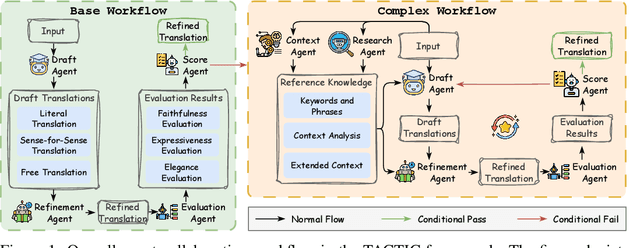
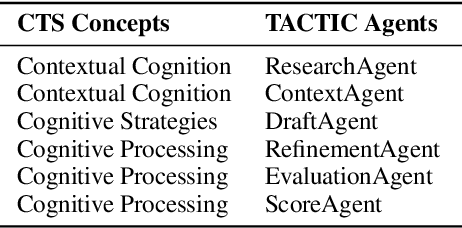
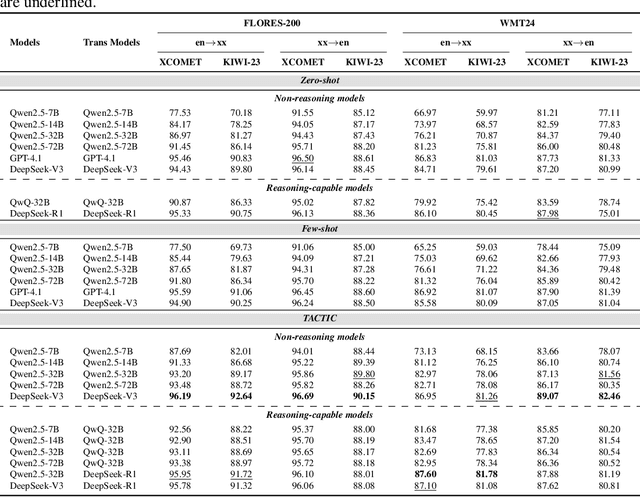
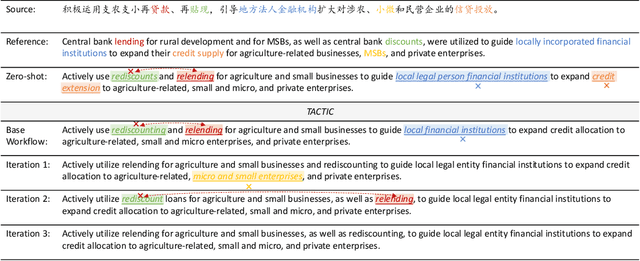
Abstract:Machine translation has long been a central task in natural language processing. With the rapid advancement of large language models (LLMs), there has been remarkable progress in translation quality. However, fully realizing the translation potential of LLMs remains an open challenge. Recent studies have explored multi-agent systems to decompose complex translation tasks into collaborative subtasks, showing initial promise in enhancing translation quality through agent cooperation and specialization. Nevertheless, existing multi-agent translation frameworks largely neglect foundational insights from cognitive translation studies. These insights emphasize how human translators employ different cognitive strategies, such as balancing literal and free translation, refining expressions based on context, and iteratively evaluating outputs. To address this limitation, we propose a cognitively informed multi-agent framework called TACTIC, which stands for T ranslation A gents with Cognitive- T heoretic Interactive Collaboration. The framework comprises six functionally distinct agents that mirror key cognitive processes observed in human translation behavior. These include agents for drafting, refinement, evaluation, scoring, context reasoning, and external knowledge gathering. By simulating an interactive and theory-grounded translation workflow, TACTIC effectively leverages the full capacity of LLMs for high-quality translation. Experimental results on diverse language pairs from the FLORES-200 and WMT24 benchmarks show that our method consistently achieves state-of-the-art performance. Using DeepSeek-V3 as the base model, TACTIC surpasses GPT-4.1 by an average of +0.6 XCOMET and +1.18 COMETKIWI-23. Compared to DeepSeek-R1, it further improves by +0.84 XCOMET and +2.99 COMETKIWI-23. Code is available at https://github.com/weiyali126/TACTIC.
Search-TTA: A Multimodal Test-Time Adaptation Framework for Visual Search in the Wild
May 16, 2025Abstract:To perform autonomous visual search for environmental monitoring, a robot may leverage satellite imagery as a prior map. This can help inform coarse, high-level search and exploration strategies, even when such images lack sufficient resolution to allow fine-grained, explicit visual recognition of targets. However, there are some challenges to overcome with using satellite images to direct visual search. For one, targets that are unseen in satellite images are underrepresented (compared to ground images) in most existing datasets, and thus vision models trained on these datasets fail to reason effectively based on indirect visual cues. Furthermore, approaches which leverage large Vision Language Models (VLMs) for generalization may yield inaccurate outputs due to hallucination, leading to inefficient search. To address these challenges, we introduce Search-TTA, a multimodal test-time adaptation framework that can accept text and/or image input. First, we pretrain a remote sensing image encoder to align with CLIP's visual encoder to output probability distributions of target presence used for visual search. Second, our framework dynamically refines CLIP's predictions during search using a test-time adaptation mechanism. Through a feedback loop inspired by Spatial Poisson Point Processes, gradient updates (weighted by uncertainty) are used to correct (potentially inaccurate) predictions and improve search performance. To validate Search-TTA's performance, we curate a visual search dataset based on internet-scale ecological data. We find that Search-TTA improves planner performance by up to 9.7%, particularly in cases with poor initial CLIP predictions. It also achieves comparable performance to state-of-the-art VLMs. Finally, we deploy Search-TTA on a real UAV via hardware-in-the-loop testing, by simulating its operation within a large-scale simulation that provides onboard sensing.
Rethinking Multi-modal Object Detection from the Perspective of Mono-Modality Feature Learning
Mar 14, 2025Abstract:Multi-Modal Object Detection (MMOD), due to its stronger adaptability to various complex environments, has been widely applied in various applications. Extensive research is dedicated to the RGB-IR object detection, primarily focusing on how to integrate complementary features from RGB-IR modalities. However, they neglect the mono-modality insufficient learning problem that the decreased feature extraction capability in multi-modal joint learning. This leads to an unreasonable but prevalent phenomenon--Fusion Degradation, which hinders the performance improvement of the MMOD model. Motivated by this, in this paper, we introduce linear probing evaluation to the multi-modal detectors and rethink the multi-modal object detection task from the mono-modality learning perspective. Therefore, we construct an novel framework called M$^2$D-LIF, which consists of the Mono-Modality Distillation (M$^2$D) method and the Local Illumination-aware Fusion (LIF) module. The M$^2$D-LIF framework facilitates the sufficient learning of mono-modality during multi-modal joint training and explores a lightweight yet effective feature fusion manner to achieve superior object detection performance. Extensive experiments conducted on three MMOD datasets demonstrate that our M$^2$D-LIF effectively mitigates the Fusion Degradation phenomenon and outperforms the previous SOTA detectors.
EliteKV: Scalable KV Cache Compression via RoPE Frequency Selection and Joint Low-Rank Projection
Mar 03, 2025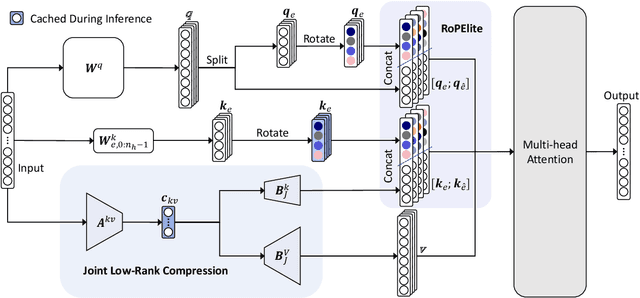



Abstract:Rotary Position Embedding (RoPE) enables each attention head to capture multi-frequency information along the sequence dimension and is widely applied in foundation models. However, the nonlinearity introduced by RoPE complicates optimization of the key state in the Key-Value (KV) cache for RoPE-based attention. Existing KV cache compression methods typically store key state before rotation and apply the transformation during decoding, introducing additional computational overhead. This paper introduces EliteKV, a flexible modification framework for RoPE-based models supporting variable KV cache compression ratios. EliteKV first identifies the intrinsic frequency preference of each head using RoPElite, selectively restoring linearity to certain dimensions of key within attention computation. Building on this, joint low-rank compression of key and value enables partial cache sharing. Experimental results show that with minimal uptraining on only $0.6\%$ of the original training data, RoPE-based models achieve a $75\%$ reduction in KV cache size while preserving performance within a negligible margin. Furthermore, EliteKV consistently performs well across models of different scales within the same family.
External Large Foundation Model: How to Efficiently Serve Trillions of Parameters for Online Ads Recommendation
Feb 26, 2025



Abstract:Ads recommendation is a prominent service of online advertising systems and has been actively studied. Recent studies indicate that scaling-up and advanced design of the recommendation model can bring significant performance improvement. However, with a larger model scale, such prior studies have a significantly increasing gap from industry as they often neglect two fundamental challenges in industrial-scale applications. First, training and inference budgets are restricted for the model to be served, exceeding which may incur latency and impair user experience. Second, large-volume data arrive in a streaming mode with data distributions dynamically shifting, as new users/ads join and existing users/ads leave the system. We propose the External Large Foundation Model (ExFM) framework to address the overlooked challenges. Specifically, we develop external distillation and a data augmentation system (DAS) to control the computational cost of training/inference while maintaining high performance. We design the teacher in a way like a foundation model (FM) that can serve multiple students as vertical models (VMs) to amortize its building cost. We propose Auxiliary Head and Student Adapter to mitigate the data distribution gap between FM and VMs caused by the streaming data issue. Comprehensive experiments on internal industrial-scale applications and public datasets demonstrate significant performance gain by ExFM.
Reconstructing Satellites in 3D from Amateur Telescope Images
Apr 29, 2024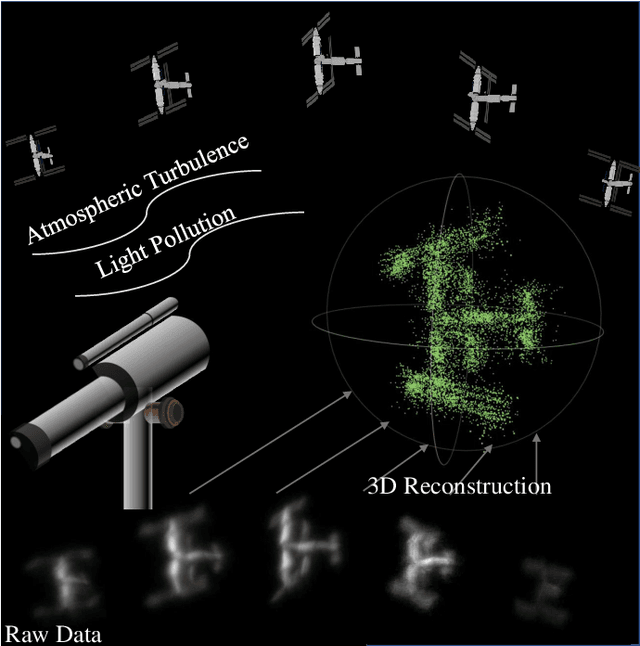

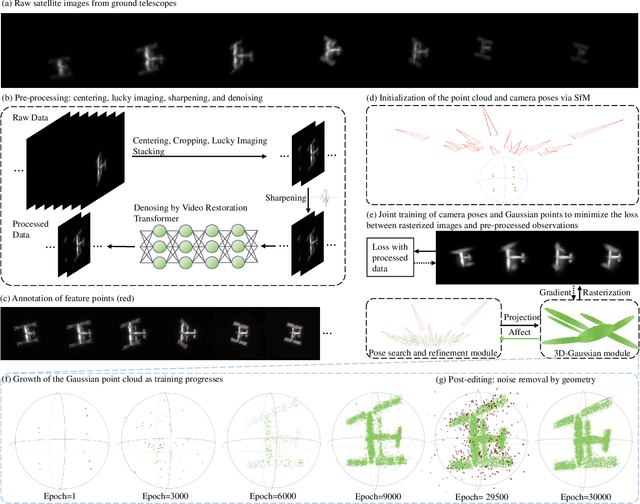
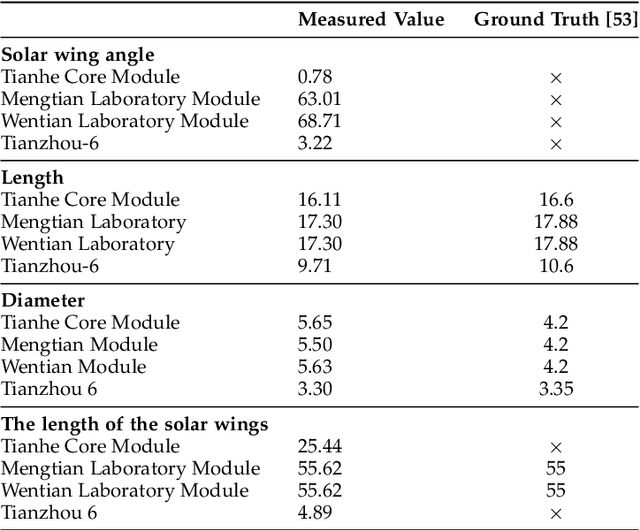
Abstract:This paper proposes a framework for the 3D reconstruction of satellites in low-Earth orbit, utilizing videos captured by small amateur telescopes. The video data obtained from these telescopes differ significantly from data for standard 3D reconstruction tasks, characterized by intense motion blur, atmospheric turbulence, pervasive background light pollution, extended focal length and constrained observational perspectives. To address these challenges, our approach begins with a comprehensive pre-processing workflow that encompasses deep learning-based image restoration, feature point extraction and camera pose initialization. We proceed with the application of an improved 3D Gaussian splatting algorithm for reconstructing the 3D model. Our technique supports simultaneous 3D Gaussian training and pose estimation, enabling the robust generation of intricate 3D point clouds from sparse, noisy data. The procedure is further bolstered by a post-editing phase designed to eliminate noise points inconsistent with our prior knowledge of a satellite's geometric constraints. We validate our approach using both synthetic datasets and actual observations of China's Space Station, showcasing its significant advantages over existing methods in reconstructing 3D space objects from ground-based observations.
Development of Automated Neural Network Prediction for Echocardiographic Left ventricular Ejection Fraction
Mar 18, 2024

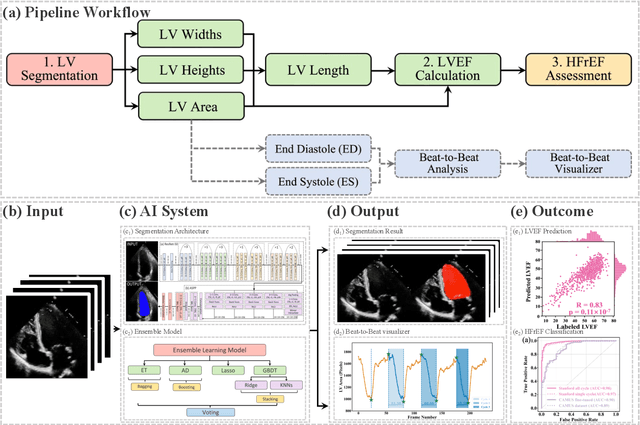
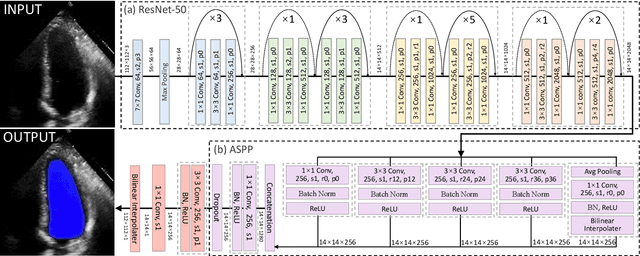
Abstract:The echocardiographic measurement of left ventricular ejection fraction (LVEF) is fundamental to the diagnosis and classification of patients with heart failure (HF). In order to quantify LVEF automatically and accurately, this paper proposes a new pipeline method based on deep neural networks and ensemble learning. Within the pipeline, an Atrous Convolutional Neural Network (ACNN) was first trained to segment the left ventricle (LV), before employing the area-length formulation based on the ellipsoid single-plane model to calculate LVEF values. This formulation required inputs of LV area, derived from segmentation using an improved Jeffrey's method, as well as LV length, derived from a novel ensemble learning model. To further improve the pipeline's accuracy, an automated peak detection algorithm was used to identify end-diastolic and end-systolic frames, avoiding issues with human error. Subsequently, single-beat LVEF values were averaged across all cardiac cycles to obtain the final LVEF. This method was developed and internally validated in an open-source dataset containing 10,030 echocardiograms. The Pearson's correlation coefficient was 0.83 for LVEF prediction compared to expert human analysis (p<0.001), with a subsequent area under the receiver operator curve (AUROC) of 0.98 (95% confidence interval 0.97 to 0.99) for categorisation of HF with reduced ejection (HFrEF; LVEF<40%). In an external dataset with 200 echocardiograms, this method achieved an AUC of 0.90 (95% confidence interval 0.88 to 0.91) for HFrEF assessment. This study demonstrates that an automated neural network-based calculation of LVEF is comparable to expert clinicians performing time-consuming, frame-by-frame manual evaluation of cardiac systolic function.
ConspEmoLLM: Conspiracy Theory Detection Using an Emotion-Based Large Language Model
Mar 11, 2024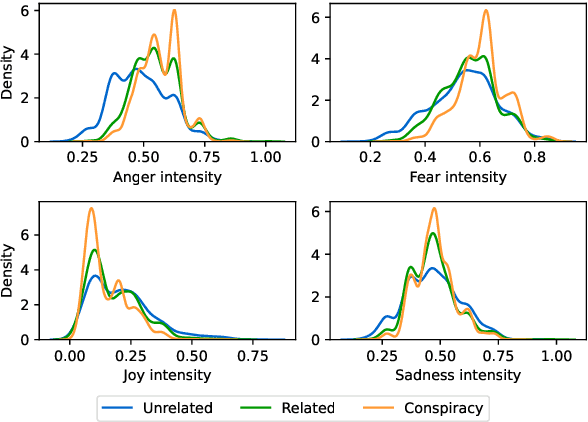
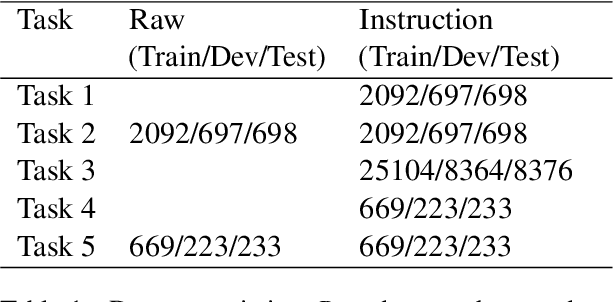
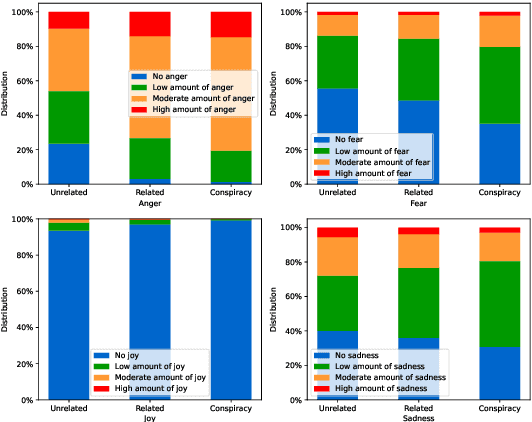
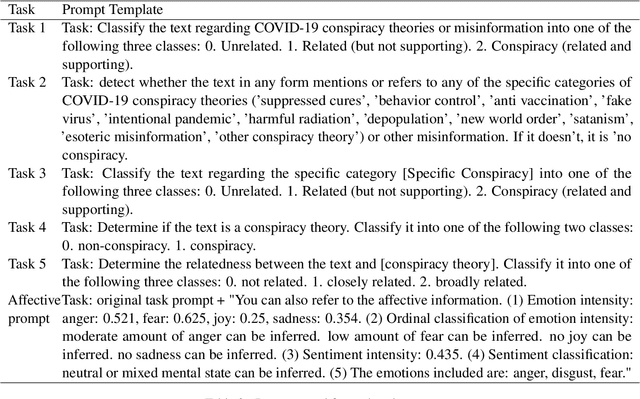
Abstract:The internet has brought both benefits and harms to society. A prime example of the latter is misinformation, including conspiracy theories, which flood the web. Recent advances in natural language processing, particularly the emergence of large language models (LLMs), have improved the prospects of accurate misinformation detection. However, most LLM-based approaches to conspiracy theory detection focus only on binary classification and fail to account for the important relationship between misinformation and affective features (i.e., sentiment and emotions). Driven by a comprehensive analysis of conspiracy text that reveals its distinctive affective features, we propose ConspEmoLLM, the first open-source LLM that integrates affective information and is able to perform diverse tasks relating to conspiracy theories. These tasks include not only conspiracy theory detection, but also classification of theory type and detection of related discussion (e.g., opinions towards theories). ConspEmoLLM is fine-tuned based on an emotion-oriented LLM using our novel ConDID dataset, which includes five tasks to support LLM instruction tuning and evaluation. We demonstrate that when applied to these tasks, ConspEmoLLM largely outperforms several open-source general domain LLMs and ChatGPT, as well as an LLM that has been fine-tuned using ConDID, but which does not use affective features. This project will be released on https://github.com/lzw108/ConspEmoLLM/.
RUSH: Robust Contrastive Learning via Randomized Smoothing
Jul 11, 2022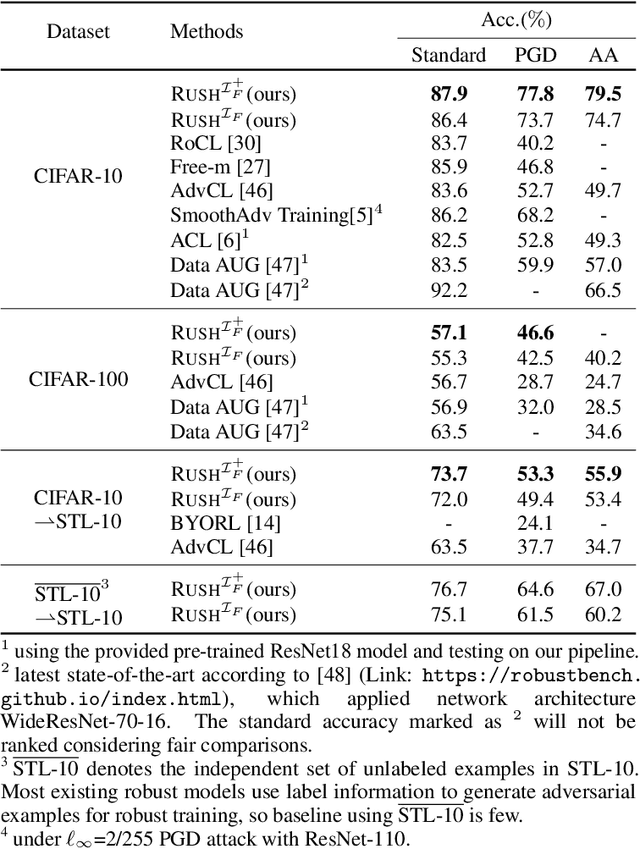
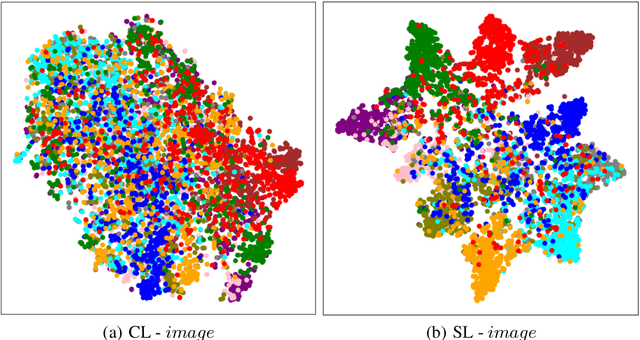
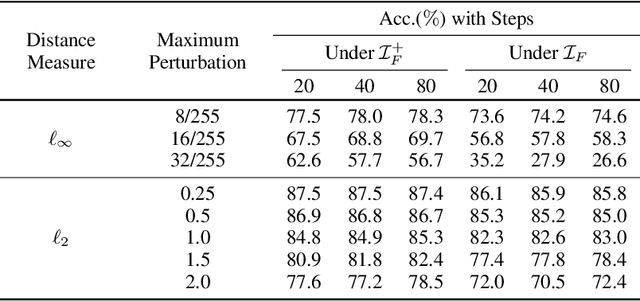
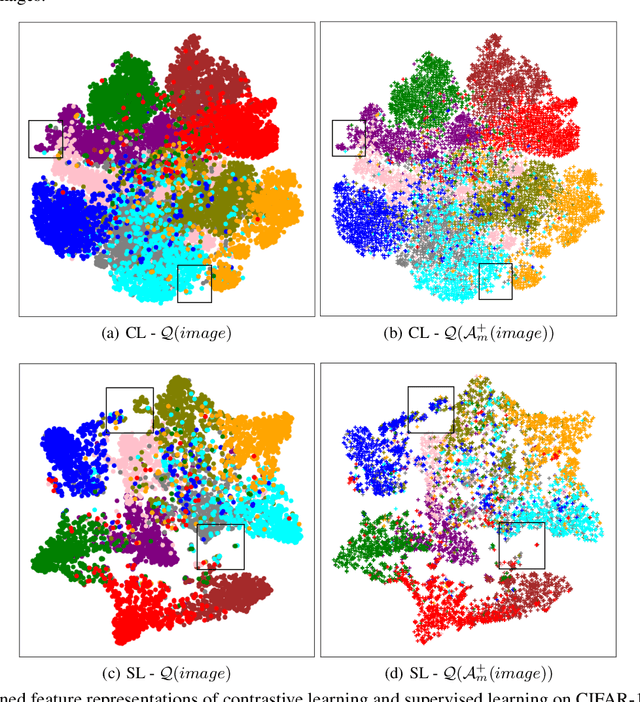
Abstract:Recently, adversarial training has been incorporated in self-supervised contrastive pre-training to augment label efficiency with exciting adversarial robustness. However, the robustness came at a cost of expensive adversarial training. In this paper, we show a surprising fact that contrastive pre-training has an interesting yet implicit connection with robustness, and such natural robustness in the pre trained representation enables us to design a powerful robust algorithm against adversarial attacks, RUSH, that combines the standard contrastive pre-training and randomized smoothing. It boosts both standard accuracy and robust accuracy, and significantly reduces training costs as compared with adversarial training. We use extensive empirical studies to show that the proposed RUSH outperforms robust classifiers from adversarial training, by a significant margin on common benchmarks (CIFAR-10, CIFAR-100, and STL-10) under first-order attacks. In particular, under $\ell_{\infty}$-norm perturbations of size 8/255 PGD attack on CIFAR-10, our model using ResNet-18 as backbone reached 77.8% robust accuracy and 87.9% standard accuracy. Our work has an improvement of over 15% in robust accuracy and a slight improvement in standard accuracy, compared to the state-of-the-arts.
Nesterov Accelerated ADMM for Fast Diffeomorphic Image Registration
Sep 26, 2021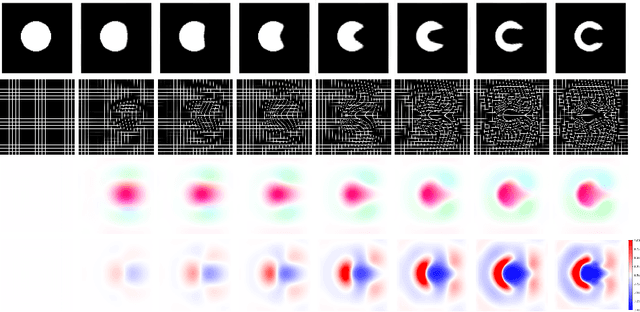
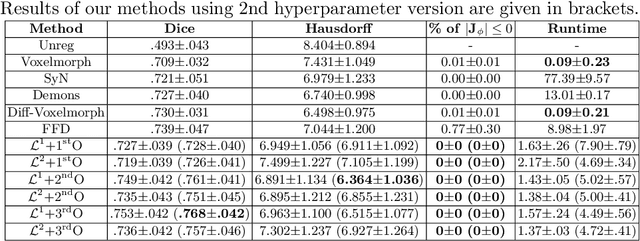

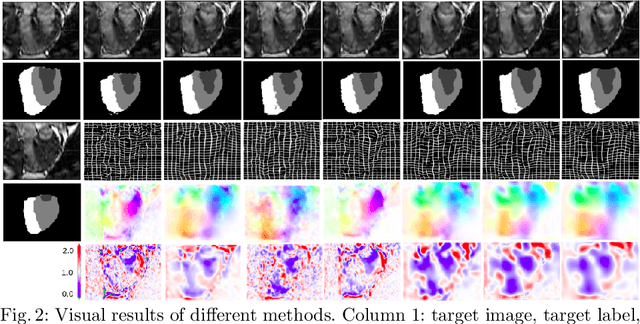
Abstract:Deterministic approaches using iterative optimisation have been historically successful in diffeomorphic image registration (DiffIR). Although these approaches are highly accurate, they typically carry a significant computational burden. Recent developments in stochastic approaches based on deep learning have achieved sub-second runtimes for DiffIR with competitive registration accuracy, offering a fast alternative to conventional iterative methods. In this paper, we attempt to reduce this difference in speed whilst retaining the performance advantage of iterative approaches in DiffIR. We first propose a simple iterative scheme that functionally composes intermediate non-stationary velocity fields to handle large deformations in images whilst guaranteeing diffeomorphisms in the resultant deformation. We then propose a convex optimisation model that uses a regularisation term of arbitrary order to impose smoothness on these velocity fields and solve this model with a fast algorithm that combines Nesterov gradient descent and the alternating direction method of multipliers (ADMM). Finally, we leverage the computational power of GPU to implement this accelerated ADMM solver on a 3D cardiac MRI dataset, further reducing runtime to less than 2 seconds. In addition to producing strictly diffeomorphic deformations, our methods outperform both state-of-the-art deep learning-based and iterative DiffIR approaches in terms of dice and Hausdorff scores, with speed approaching the inference time of deep learning-based methods.
 Add to Chrome
Add to Chrome Add to Firefox
Add to Firefox Add to Edge
Add to Edge